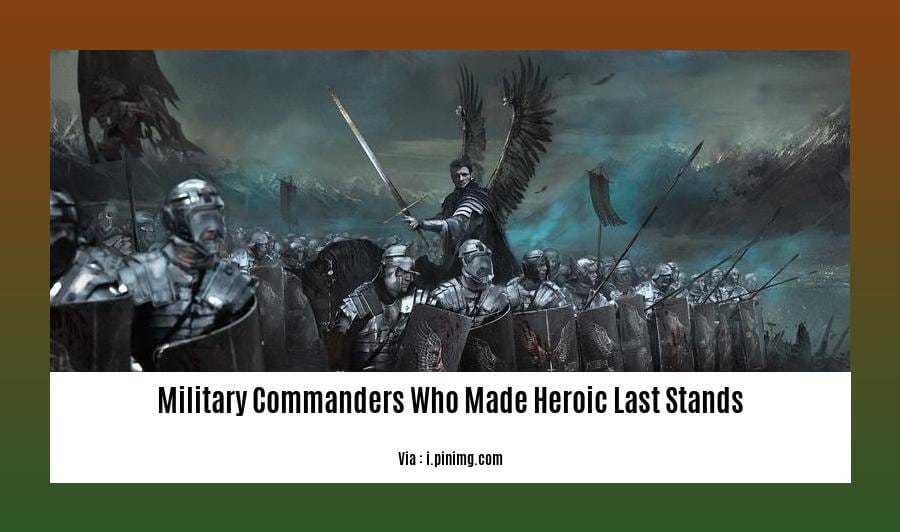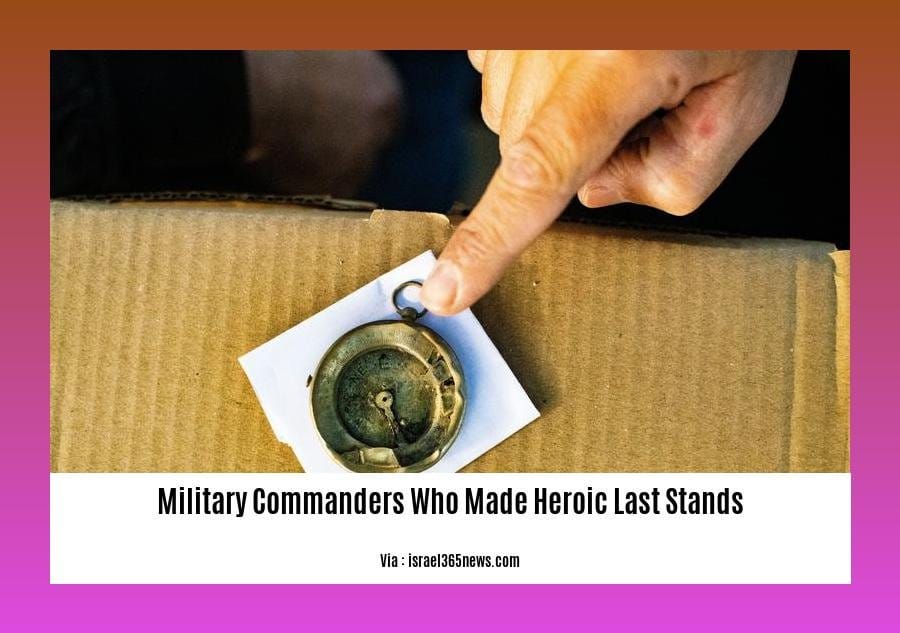Delve into the annals of warfare and discover the extraordinary tales of Iconic Military Commanders Who Made Heroic Last Stands. These valiant warriors faced overwhelming odds and insurmountable challenges, yet their indomitable spirit and strategic brilliance left an enduring mark on the annals of history. From Leonidas’ legendary stand at Thermopylae to Pickett’s fateful charge at Gettysburg, these commanders epitomized the courage, determination, and unwavering resolve that has defined the art of warfare for centuries.
Key Takeaways:
- Definition of Heroic Last Stand: A battle where a severely outnumbered and outmatched force fights valiantly to the death, facing insurmountable odds.
- Historical Significance: These last stands become legendary moments, showcasing the courage, sacrifice, and unwavering spirit of the defenders.
- Notable Examples:
- Battle of Thermopylae (480 BC)
- Battle of Gaixia (202 BC)
- Battle of Numantia (133 BC)
- Swiss Guard Defense of the Vatican (1527)
- Battle of Shiroyama (1877)
- Factors Leading to Last Stands:
- Overwhelming odds and inferior force
- Limited resources and reinforcements
- Strategic importance of defending a position
- Cultural or ideological motivations
- Legacy: These last stands inspire generations, serve as a reminder of war sacrifices, and emphasize the significance of courage and determination.
Military Commanders Who Made Heroic Last Stands
In the annals of warfare, certain battles stand out as heroic last stands, where outnumbered and outmatched forces fought valiantly against overwhelming odds. These moments of indomitable courage and determination have left an enduring legacy, inspiring future generations.

Notable Military Commanders Who Made Heroic Last Stands:**
Leonidas I at Thermopylae (480 BC): With just 300 Spartans, Leonidas held off the Persian army for three days, buying time for the rest of Greece to prepare for the invasion.
Xiang Yu at Gaixia (202 BC): Facing Liu Bang’s superior forces, Xiang Yu led his army in a fierce but ultimately unsuccessful defense, choosing to take his own life rather than be captured.
Titus Pullo at the Battle of Numantia (133 BC): A Roman centurion who famously held a bridge single-handedly against the Celtiberians, allowing his comrades to escape.
Captain Kaspar von Silenen at the Swiss Guard Defense of the Vatican (1527): With just 189 Swiss Guards, Silenen defended Pope Clement VII against the Holy Roman Empire, sacrificing their lives to the last man.
Saigō Takamori at the Battle of Shiroyama (1877): Leading a group of samurai against the Imperial Japanese Army, Takamori fought until the end, committing seppuku rather than surrendering.
Factors Contributing to Last Stands:
- Extreme disparities in numbers and equipment
- Limited reinforcements and resources
- Strategic importance of holding a position
- Cultural or ideological motivations
Legacy of Last Stands:
Last stands serve as powerful reminders of the sacrifices made in war. They inspire awe and admiration for the courage and determination displayed by those who fought against insurmountable odds. These battles have become symbols of hope, perseverance, and the indomitable spirit that resides within us all.
Discover how military commanders have been recognized for their unwavering bravery and exceptional leadership in the face of adversity. Read about the bravest acts of military leadership and learn about the commanders who triumphed against insurmountable odds.
Boudicca vs. Suetonius Paulinus
Key Takeaways:
- Boudicca’s Rebellion (60 AD): Led by Boudicca, Queen of the Iceni, after Roman oppression and disrespect.
- Sackings: Led her army to sack the Roman towns of Camulodunum and Londinium.
- Suetonius’s Response: Governor Gaius Suetonius Paulinus regrouped his forces to face Boudicca at the Battle of Watling Street.
- Battle of Watling Street (61 AD): Suetonius’s army (10,000) triumphed over Boudicca’s (230,000).
- Roman Victory: Reasserted Roman authority in Britannia, ending Boudicca’s rebellion.
Roman Tactics:
- Organized legions in a disciplined formation.
- Used cavalry to charge the flanks of Boudicca’s infantry.
- Exploited superior weaponry and training.
Boudicca’s Forces:
- Mostly untrained warriors and women.
- Overwhelming in numbers but not tactics.
- Chariots harassed Roman flanks.
Aftermath:
- Boudicca’s defeat ended the rebellion.
- Reprisals by Roman legions destroyed Celtic settlements.
- Suetonius’s victory established Roman dominance in Britannia.
Citation:
– https://stmuscholars.org/the-british-disaster/
The Spartans at Kunyang
When we think of heroic last stands, images of the Spartans at Thermopylae valiantly holding off the Persian hordes often come to mind. Yet, history is replete with countless other examples of warriors who have fought with unwavering determination against overwhelming odds. One such episode, etched into the annals of military history, is the epic battle known as The Spartans at Kunyang.
In 21 AD, a small band of around 400 Roman legionaries, along with allied auxiliary troops, found themselves besieged by a massive army of over 100,000 Chinese rebels. The Roman cohort was part of a larger force under the command of Publius Quinctilius Varus, who had been dispatched to quell a rebellion in the Chinese province of Jiaozhi (modern-day Vietnam).
The rebels, led by the charismatic general Wang Lang, laid siege to the city of Kunyang, where the Romans had taken refuge. Despite being outnumbered by more than 250 to 1, the Romans refused to surrender. They hastily constructed a fortified camp and prepared to defend themselves against the overwhelming rebel force.
The siege of Kunyang lasted for several months, during which time the Romans endured constant assaults from the rebels. Time and again, the rebels hurled themselves at the Roman fortifications, but the legionaries stood firm, repelling each attack with unwavering discipline and courage.
The Romans’ staunch defense and the rebels’ inability to breach their fortifications eventually led to a stalemate. However, the situation for the Romans was dire. They were running low on supplies and reinforcements were nowhere to be found. Yet, despite the grim circumstances, the Romans refused to give up. They knew that surrender meant certain death.
In a desperate attempt to break the siege, the Roman commander, Publius Vinicius, led a daring sortie against the rebel forces. The Romans fought with incredible bravery, but they were heavily outnumbered and outmaneuvered. Vinicius was killed in the battle, and the Roman sortie was defeated.
With their commander dead and their situation growing increasingly desperate, the Romans realized that their time was running out. They decided to make one final stand, a last-ditch effort to break out of the besieged city.
On the day of the final assault, the 400 remaining Roman legionaries formed up in a tight formation and charged out of their camp. They fought their way through the rebel ranks, desperate to escape the city. The rebels, sensing the Romans’ desperation, fought with renewed ferocity.
The battle raged for hours, and the Romans fought with incredible valor. They killed countless rebels, but their numbers dwindled with each passing moment. One by one, the Roman legionaries fell, until only a handful remained.
In a final act of defiance, the last surviving Roman, a centurion named Vettius Valens, refused to lay down his arms. He fought on alone, surrounded by a sea of rebels. Eventually, Valens was overwhelmed and killed, but his heroic stand became a symbol of the indomitable spirit of the Roman legionnaires.
Key Takeaways:
- The Battle of Kunyang was a heroic last stand by a small band of Roman legionaries against an overwhelming force of Chinese rebels.
- The Romans endured months of siege and constant attacks, but refused to surrender.
- Despite their desperate situation, the Romans fought with unwavering discipline and courage.
- The last surviving Roman, Vettius Valens, made a final stand, refusing to lay down his arms.
- The Battle of Kunyang is a testament to the indomitable spirit of the Roman legionnaires.
Source:
The Battle of Kunyang: A Roman Last Stand in China
Masada and the Siege of Masada
In 73 AD, a poignant drama unfolded on the remote mountaintop fortress of Masada, where Jewish rebels made a final, desperate stand against the invading Roman legions. Led by the charismatic Eleazar ben Ya’ir, these rebels defied overwhelming odds, holding out for over two years against the relentless siege.
The Roman army, under the command of Lucius Flavius Silva, surrounded Masada, cutting off all supplies. Despite the hopeless situation, the rebels refused to surrender. Driven by religious zeal and a fierce determination to preserve their freedom, they fought with unwavering courage.
For months, the siege raged on, with the Romans using siege towers and battering rams to breach the fortress walls. The rebels fought back with ingenuity and tenacity, repelling countless Roman attacks. As their situation grew dire, Eleazar rallied his followers, urging them to choose death over dishonor.
On the final day, the Romans breached the fortress. Rather than surrender, the rebels chose to take their own lives in a mass suicide, a tragic but defiant act that has resonated throughout history. The siege of Masada became a symbol of Jewish resistance and has inspired countless stories of courage, sacrifice, and the indomitable spirit that can triumph even in the face of defeat.
Key Takeaways:
- Masada’s historical significance: As the site of a heroic last stand against overwhelming odds, Masada has become a symbol of Jewish resilience and resistance.
- The determination of the Jewish rebels: Led by Eleazar ben Ya’ir, the rebels exhibited extraordinary courage and tenacity in their protracted defense of Masada.
- The tragedy of the mass suicide: The decision of the rebels to end their own lives rather than surrender to the Romans epitomizes the depth of their despair and their commitment to their beliefs.
- The enduring legacy of Masada: The siege of Masada continues to inspire and captivate people worldwide, serving as a testament to the human capacity for courage, sacrifice, and defiance in the face of adversity.
Source:
* Josephus, The Wars of the Jews, Book VII, Chapter 8-9 (cited in “The Siege of Masada” by the Biblical Archaeology Society:

FAQ
Q1: Who are some iconic military commanders who made heroic last stands?
Q2: What are some of the most famous heroic last stands in military history?
Q3: What factors contribute to a heroic last stand?
Q4: What is the legacy of heroic last stands?
Q5: How can we learn from the heroic last stands of military commanders?
- Mastering Leader in Spanish: The Complete Guide - April 19, 2025
- Uncovering Surprising Parallels: England Size Compared to US States - April 19, 2025
- Old Mexico Map: Border Shifts 1821-1857 - April 19, 2025
















